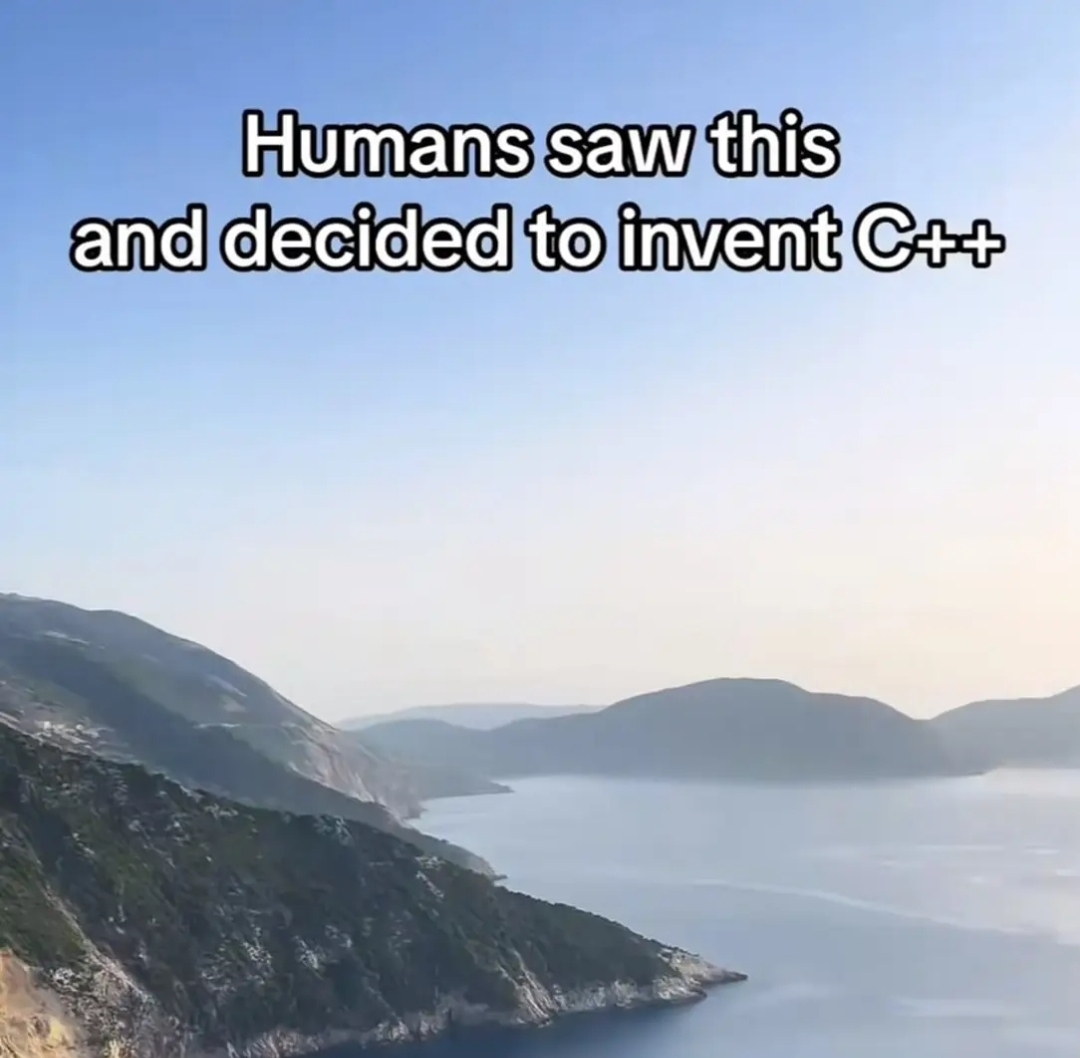If you assume that a “bullet” is a unit of momentum (the mass and velocity of a bullet) and “square child” is actually just referring to the mass of a child who happens to be square shaped and not the mass of a child squared, then “bullets per square child” is describing valid units for a velocity
“Preposterous twaddlecock Time travel is impossible!”
“But Professor, you time traveled yourself. Remember? When we went back to Roswell?”
“That proves nothing! And furthermore, you'd think I could remember a thing like that! Plus, who are you anyway?”
Geologically, ice is a mineral, aka a rock. If lava is just rock heated past its melting point, water is lava.
The state (as defined by Engles, Marx, Lenin, etc.) is the problem. Like this is exactly what it does by definition.
If the government forms an alliance with the market it becomes a slave to the market.
There are more homes than homeless, more food than starving kids. Life saving medicines can be extremely cheap to produce but are sold for fortunes. Everywhere you look, the bourgeoisie are literally holding people’s lives for ransom… and the government does nothing.
In fact the government does less than nothing. It is the government that facilitates the hoarding of these resources. It is the government that enforces patent laws that allow life saving medicines to be kept from those in need. It is the government that enables and legalizes this racketeering by the rich.
When you live in a society where politicians talk equally (or more) about how they’ll help the market as they talk about how they’ll help their citizens—which is what their job is supposed to be—are you really surprised?
Are you really surprised that a government which chooses to let its people go unhoused just to keep the real estate market up is a government in which wealth holds the power? Are you surprised that a government that shuts down worker strikes and forces compromise on the side of the exploited rather than solely on the side of exploitative corporations is a government that can be manipulated by the owner of multiple massive companies?
There is nothing surprising here. The system is working exactly as it is intended to. The problem is not a few members of the bourgeoisie colluding to manipulate the state because that’s how the state always works. The problem is the state.
If you would like to learn more about “the state” I suggest you read State and Revolution. That’s what made me switch from “oh we just need to tax the rich” to “the rich should not exist.” It also is just kind of impressive how Lenin describes many things that are very relevant today despite the fact he wrote this short book over a century ago.
Don’t forget his birthday and his mother’s maiden name too
“Mr. Doctor man questions his hands…”
See I agree with your last statement. I mean “any” is a stretch but yeah there probably are other systems involving distance based forces that we could draw similarities to chemistry from.
I guess the issue here is that my argument is there are similarities and your argument is that one shouldn’t point out similarities unless there are enough of them…?
Your first paragraph implies you thought I meant just setting these systems statically next to each other would create a stable orbit. You’re right, that would be wrong. But I don’t think I ever mentioned stationary combination. Furthermore, while regular chemistry could work like that, in the real world every atom is moving. The bonds form when atoms get close enough. This is why temperature increases chemical reactions. More motion means more “collisions” that aren’t really collisions but you get the picture.
Objects in space are also constantly in motion. If you want to bring two stellar systems together, you need to give them velocities relative to each other. Or as you put it, momentum. This could be enough to ensure a stable system but it requires that the velocities at least a roughly specific which is what I meant when I said system chemistry would be highly directional in my original comment.
As for magnets. You could say both atoms and magnetic systems run on similar forces. You could make the argument that they, like atoms, have components which are constantly in motion and that if perturbed enough one could overcome those forces and break the system into its individual components.
However the behavior of the system as a whole is not similar to atoms because it cannot form any bonds of any kind with other similar systems.
If you were able to find magnetic monopoles which may or may not exist, you could probably build a system that is much more atom like than a gravitational system. But with magnets that have dipoles, even a ferromagnetic material would be drawn to one pole or the other. I suppose you could get up to two ferromagnetic bodies to orbit a rotating bar magnet if the velocities and distances were right, but you wouldn’t be able to combine them because moving any magnet closer would disrupt the conditions needed for stability.
Magnets are much more sensitive than gravitational systems because the objects have to be large relative to the system and close together whereas gravitational systems can be ginormous like Alpha Centauri.
Anyway it’s fun to think about what exactly I would count as chemical like properties.
I’d say they are mostly just the following:
- A unit system is made of different components that are held together by some distance based force in a specific state of equilibrium; the unit has a space near the center containing the majority of the mass, and the unit can on some scale be treated as a particle.
- Both components and units are separated by a functionally empty medium
- Units can lose/gain/steal components from other units
- A unit’s components and their amount/locations/motion change the way it interacts with other units
- Some components can combine into a single component, split into multiple functioning components, or decay
- Units can decay spontaneously or as a result of physical interaction
- The removal or addition of a component to a unit can cause the unit to become unstable but does not always do so
- Units interact with other units via a distance based force and can form stable multi unit equilibrium states, combine into a single unit, or destabilize entirely.
- The specific equilibrium state (shape/configuration)of a multi unit system affects how it will interact with other units or multi unit systems.
- Units can be removed from multi unit systems by other multi unit systems or external units with or without destabilizing the rest of the system from which it is removed.
- Units and systems with similar enough configurations will react in similar ways
I think that covers it. So if you can find a system that fits those then I’d say there are similarities between them and atoms/chemistry. I will honestly be pretty excited if you do because it will be interesting.
Gravitational capture occurs when one object enters a stable orbit around another (typically referring to natural orbits rather than orbit insertion of a spacecraft with an orbital maneuvers).
So saying it “is not possible” is verifiably wrong. The perceived rarity of gravitational capture is most likely just due to how empty space is, not the unlikelihood of stability.
On that note, I think you might want to do some math yourself. You seem to be laboring under the impression that there are limited or maybe only a single exact state of stability for systems like this. “You have to perfectly set the velocities and magnetic moments” I’m not sure about magnets but I am sure about gravitation, and you don’t need to be very precise at all.
If you know how to code I’d suggest you try simulating two bodies with random masses traveling at random velocities. You’ll see that many times they do swing apart and a few times they will directly collide but there is a wide range of stable orbits. Sure, if you wanted to get perfectly circular orbits, you’d need to be more precise, but circular orbits are not necessary at all. Most orbits are at least a little eccentric, and eccentric orbits are still stable orbits. Importantly, they can be created without precision.
Next, while binary systems are assumed to form during star formation as you assert, the quote I listed from Wikipedia says it is possible for binary systems to form via gravitational capture.
Anyway, since that wasn’t enough evidence for you I decided to find an example of a combination system. Fortunately I didn’t have to look very far.
Alpha Centauri (our nearest stellar neighbor and triple star system) is a specific example of stable combination. Rigil and Toliman are main sequence stars that likely formed the way you listed since they are very close together and roughly the same size with slightly more massive than the other.
However, Proxima Centauri is a red dwarf that orbits the two circumbinarily. It is .2 light years from the other two which means it is roughly 5% of the distance to us from the barycenter of Toliman and Rigil.
However, despite the distance, it is “gravitationally bound” to them and its orbit has a 30deg inclination relative to them. This out of plane motion, the large distance, and the eccentricity of its orbit, imply that Proxima Centauri did not form from in the ways you listed. It may have formed in the same nebula as the other two, but it also very possibly could have travelled before getting gravitationally captured. In either case, it was gravitationally captured by some means and has formed a stable system despite having an out of plane velocity.
Proxima Centauri even has circumstellar planets, and its small mass and large distance from the binary pair mean it very easily could be stolen from the system if another main sequence star passed closely by. So it’s a great example of this “bonding” I’ve described.
Now magnets. Your magnet analogy is not similar to these scenarios because electromagnetism is highly directional. I don’t think you’d be able to combine systems of spinning magnets in any stable configuration other than a straight (spinning) line of them. However—as shown by the Alpha Centauri system—it is very possible to form stable multistellar systems from the combination of two stable systems.
Lastly you are correct that there are many many differences between atoms and gravitational systems. I mean shit, we don’t even know how atoms really work. String theory and particle physics don’t play nice and there are many more theories for unifying relativity and quantum physics that would impact what the “true” internal structure of an atom is like.
However, as mentioned in my last comment, that is not the point! My point was simply that there are some similarities and that you could do certain things with them that would have chemistry analogues. Does that make sense? I’m not saying “these are the same” I’m saying “it might be possible to use these in some similar ways to atoms.” And I’ve now found proof it is possible because of this debate, but the point of my original comment was curiosity/discovery not debate.
Firstly, you are wrong. Binary star systems are a good example this. Secondly, thank you for helping me find more similarities between atoms and stellar systems and learn new words.
From the Wikipedia page for Binary Star System:
it is not impossible that some binaries might be created through gravitational capture between two single stars
Again is it unlikely? Hell yeah but I covered that point previously and the important part is that it is still possible.
Next, I need to thank you because you helped me find out that your “nuclear type reactions” happen and are similar to nuclear combination of atoms.
The orbits of planets in a binary system can be circumbinary which would be the “nuclear type” as you called it where the stars (or most massive body in the system) begin orbiting each other and planets orbit around both as though they were a single massive object.
However, they can also be circumstellar (as I described previously) meaning the two stars orbit each other but the planets orbit only one star each. This would be much more analogous to an ionic bond (though again without polarity) where two atoms are attracted to one another but do not share electrons.
Furthermore, it seems there is even more similarity as the circumbinary systems are more unlikely to break apart but the circumstellar type require stars to be far enough away would make them more easily dislodged. This seems similar to nuclear decomposition being much harder to pull off than chemical decomposition.
But wait, there’s more.
Some binary stars orbit each other so closely that they share the same atmosphere, giving the system a peanut shape. While most such contact binary systems are stable, some do become unstable and either eject one partner or eventually merge.
Even if the stars get close enough to touch, they can still be differentiated and are “stable” This seems much more like a nucleus since the “particles” are packed tightly together and the whole “becoming unstable means I eject a particle” kind of screams radioactive decay.
Anyway, there are “periodic solutions” (stable configurations that follow a cycle) to the three body problem and there are likely some for n-bodies. So contrary to your assertion, it is possible to make a stable system with multiple massive bodies that do not combine “nuclear type”.
As you can see from the images on the Wikipedia page, these systems have unique shapes which is what I was referring to as the analog of proteins having specific shapes.
Lastly, the first line of my original comment was that yes, these solar sustems are reminiscent of a wrong model of the atom. I’m well aware of the structure of electron orbitals and Schrödinger’s equations for electron position etc.
My point was not to say that stellar systems are structured just like atoms or behave exactly like them either. My point wasn’t even that there are more similarities that differences. It was simply that there are similarities between the two and that you could build some analogous structures/chemistry with gravitational systems.
Oh yeah eventually they will. But eventually protons will decay. Could you do something with these bonded “atoms” before they collapse? Probably not as much as you can before an atom decays but yeah you’ve definitely got at least a few million years for most systems right?
While others have correctly pointed out that the model of atom which is reminiscent of a solar system is not accurate. I would like to point out that systems of massive bodies in space could possibly be used in some ways similar to atoms.
The closer you get the stronger the pull is, but if you’re going fast enough, you can find stable configurations. This means it is possible (though incredibly unlikely) that if two solar systems interacted the right way, you could get a stable combined system. Two systems could orbit each other with or without sharing planets which is reminiscent of certain kinds of atomic bonds. You can even have system interactions where one system steals a planetary body from another. Sure there’s no ionic bonding because gravity isn’t polar but it’s still possible to create “bonds” of some kind.
Also, the specific configuration, total mass, and number of massive bodies in each system would affect how it interacts with any other system, kind of like chemical properties of elements.
If you throw a massive enough thing fast enough you can rip a solar system apart kind of like how throwing a neutron or nucleus fast enough at an atom can break it apart.
Complex gravitational systems can have specific and often complex physical structures/shape too, which could be argued as similar to the way proteins have complex and specific shapes. These shapes would change the way the systems interact with other systems because gravity and distance are related. Again creating these stable configurations would be unlikely but still not impossible.
Hell, there are even weirder similarities too. Stars and black holes “decay” and the collision of planets can yield different numbers of “particles” which interact in new ways because their mass is different.
Sure, gravitational systems are not nearly as stable as atoms, they probably couldn’t be ordered into a table like elements, and do not operate on exactly similar forces like atoms. System-chemistry would also be very directional which would be tedious, but I think it’s cool that it could be possible to do similar things with gravitational systems as you can with atoms, even if they don’t have similar structure or internal properties.











Destiny has cheated me by forcing me to decide upon: The woman that I idolize, or the hands of an automaton.
Without these hands I can’t complete the opera that was captivating her
But if I keep them, and she marries him, He probably won’t want me dating her.